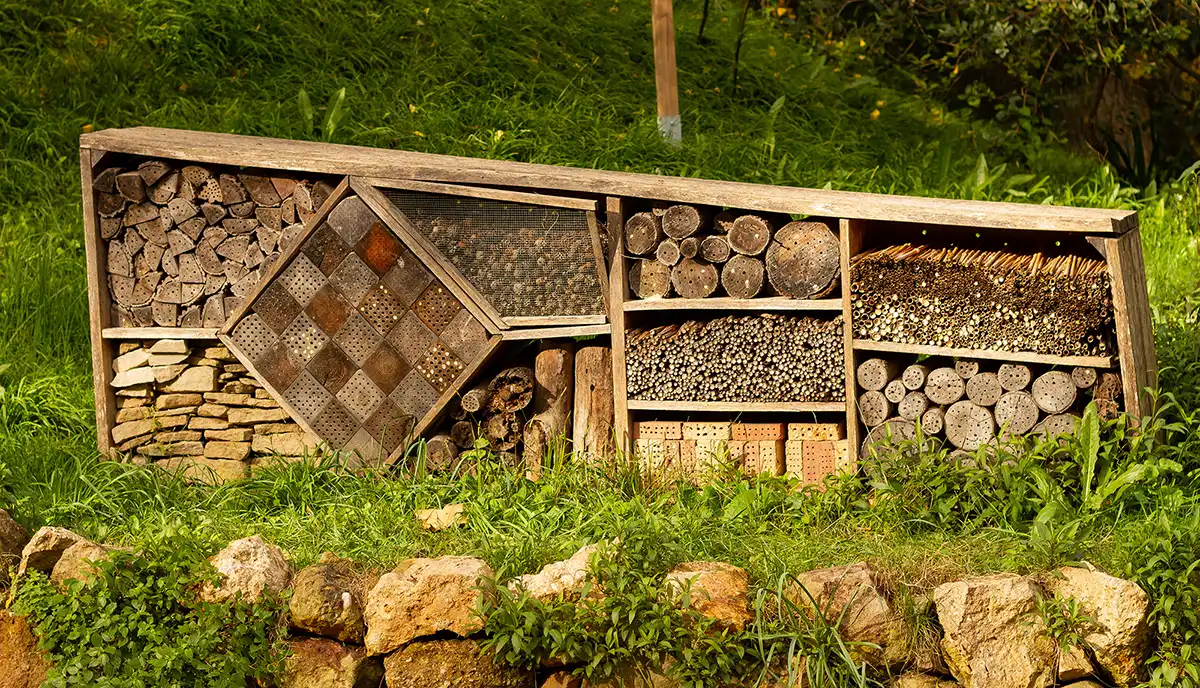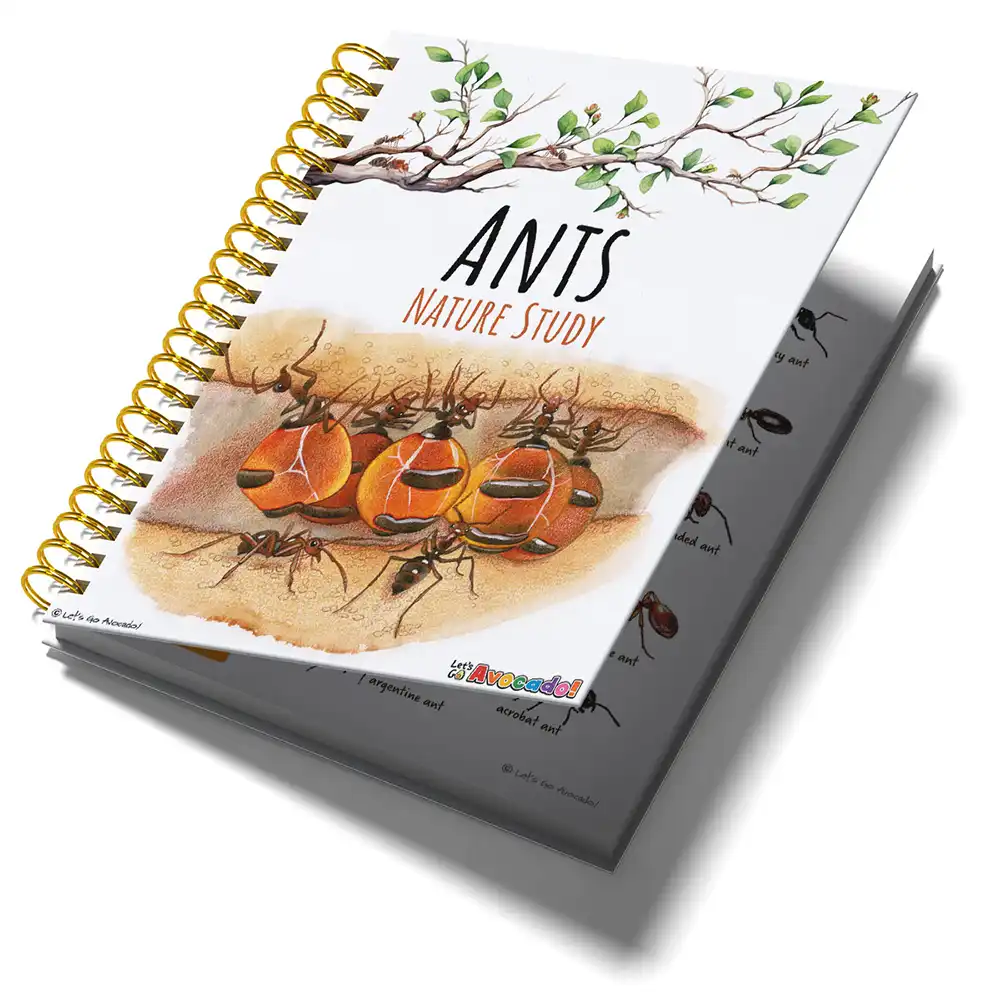This page may contain affiliate links.
Read our disclosure and privacy policy here.
Bug hotels are a great way to invite nature’s smallest critters into your back yard. Bugs will come from far and wide to try out your new construction. Building a bug hotel is fun and easy, and it’s helpful to the environment because it gives shelter to a variety of insects, arthropods, and other small animals. Here’s how you can make your very own bug hotel.
Table of Contents
DIY: How To Make A Bug Hotel
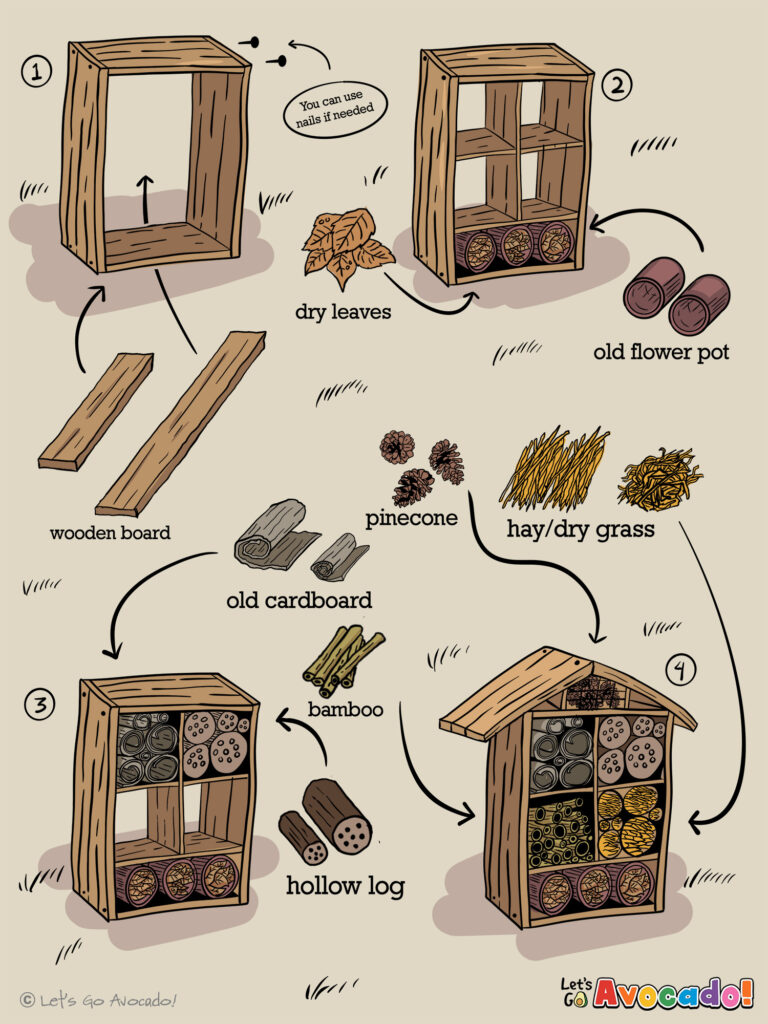
List of Materials & Tools
Materials Required
- A wooden box or frame (you can recycle an old wooden crate or build one from scratch)
- Bamboo sticks, hollow plant stems, or cardboard tubes
- Pinecones
- Twigs, small branches, and leaves
- Small stones or bricks
- Straw or hay
- Garden twine or string
- Moss, bark, pine needles, and small pieces of wood
Recommended Tools
- Safety glasses for everyone
- Drill
- Hammer & Nails / Staple gun
- Radial-arm saw or table saw for cutting the wood frame if needed.
- could also use a jig saw, hand saw, band saw…
- Paint & Paintbrushes if you want to decorate
Step 1: Build The Frame
If you’re building the frame from scratch, create a simple box shape using wooden planks. Nail or staple the planks together securely. Make sure the front is open – this is where the bugs will check in! You can also use a wooden crate you find in the trash or recycling. Reusing found objects can speed up your build!
Step 2: Assemble Your Materials
Collect a variety of natural components, like twigs and stick, bamboo, dried leaves, pine cones, dry grass and hay, and so on. Also start gathering materials like old flower pots and cardboard, to help combine some of the natural elements you find. If you find some firewood logs, use a drill to make holes in the wood where bugs and critters can get cozy!
Use rope to tie sticks, twigs, grass, and hay into bundles, and stuff dry leaves into flower pots. Make sure each component you create is small enough to fit into your but hotel. Check out the pictures below for some inspiration about the kinds of things you can place in your bug hotel.
Step 3: Make Rooms In Your Bug Hotel
Now it’s time to give bugs a variety of cozy rooms. Fill the different sections of the bug hotel with different materials to attract various insects. Use all the components you assembles in step 2, and start filling in your bug hotel. Use wood pieces to separate the various rooms of your bug hotel if you want.
Bamboo and Hollow Stems: Stuff bamboo sticks, hollow plant stems, or cardboard tubes into some sections. These will be perfect hideaways for solitary bees and ladybugs.
Pinecones: Bugs like lacewings and spiders will love snuggling in pinecone nooks.
Twigs and Leaves: Fill a section with twigs, small branches, and leaves. These will attract beetles and other ground-dwelling critters.
Stones or Bricks: Create small crevices with stones or bricks for insects like ants.
Step 4: Decorate Your Bug Hotel
Get creative! Add pieces of moss, bark, pine needles, and small pieces of wood to give your bug hotel a natural look.
You're Done!
Congratulations, you’ve built a bug hotel that will give insects a cozy place to stay in your garden. It’s a wonderful way to help these little critters while learning more about the fascinating world of bugs!
Place your bug hotel in the chosen garden spot. Make sure it’s stable and won’t tip over easily.
Now comes the fun part – watching bugs check in! Keep an eye on your bug hotel and see who moves in. You might spot bees, butterflies, beetles, spiders, and more!
- Check your bug hotel every now and then to make sure it’s still stable and safe.
- In the winter, some bugs might use it to hibernateHibernation is a remarkable survival strategy used by some animals to endure harsh winter conditions. During hibernation, these animals enter a deep, prolonged state of reduced activity, characterized by a significant drop in metabolic processes, including heart rate and body temperature, allowing them to conserve energy and survive through the challenging cold months. Learn More. Leave it untouched until spring.
- If you notice any signs of decay, replace old materials with fresh ones.
Some Inspiration!
Take a look at some of these images of bug hotels to get inspiration! Your bug hotel can be as large or as little as you want, so have fun, and do what you can with the materials you have.
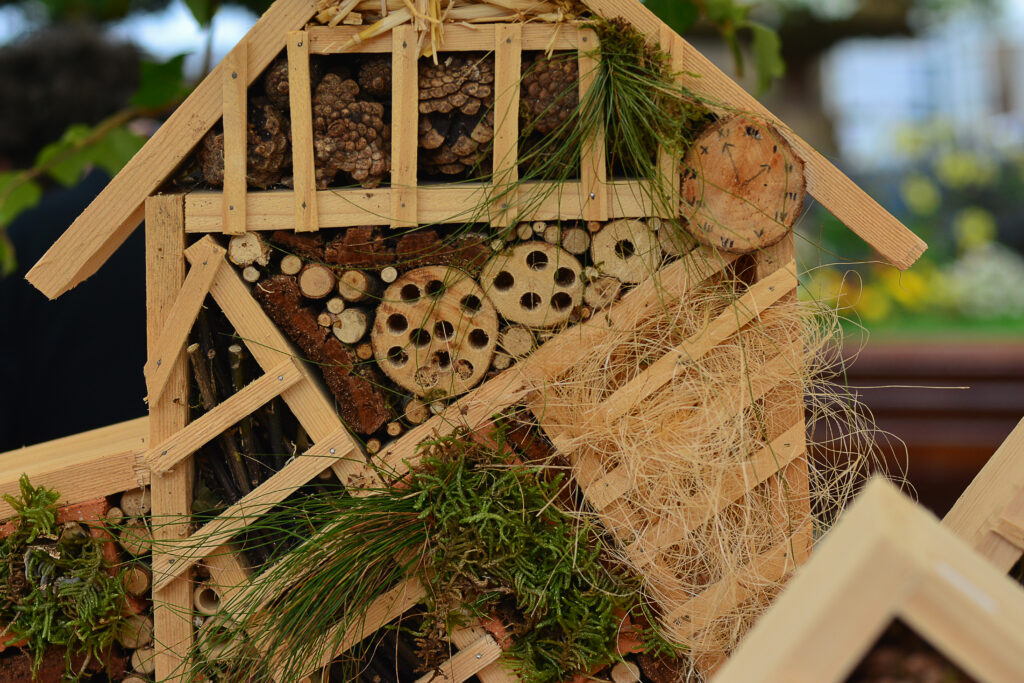
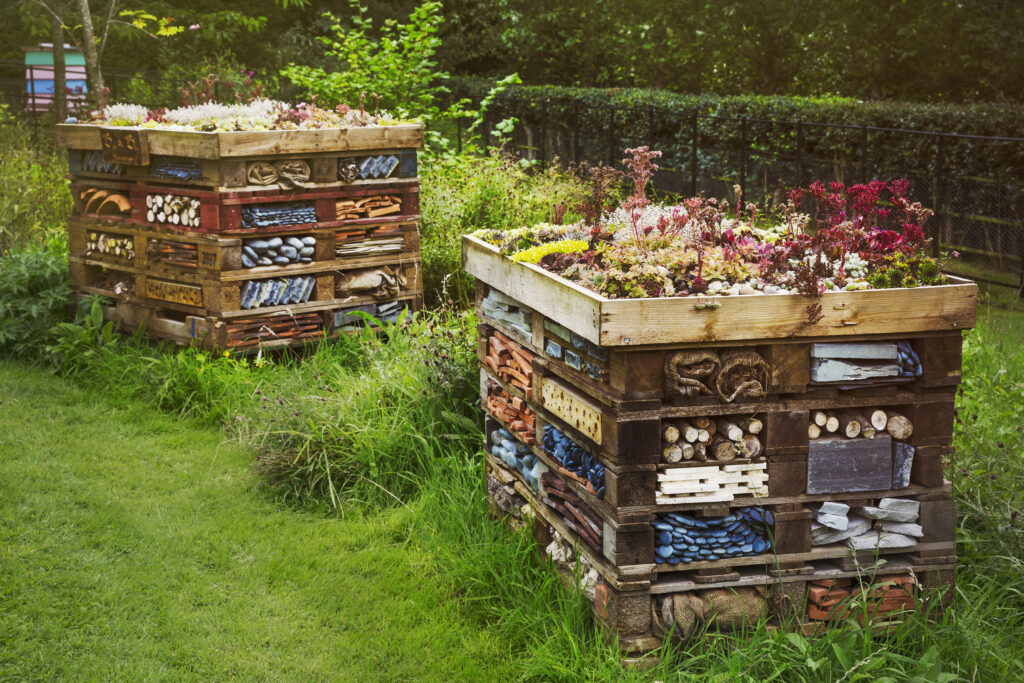
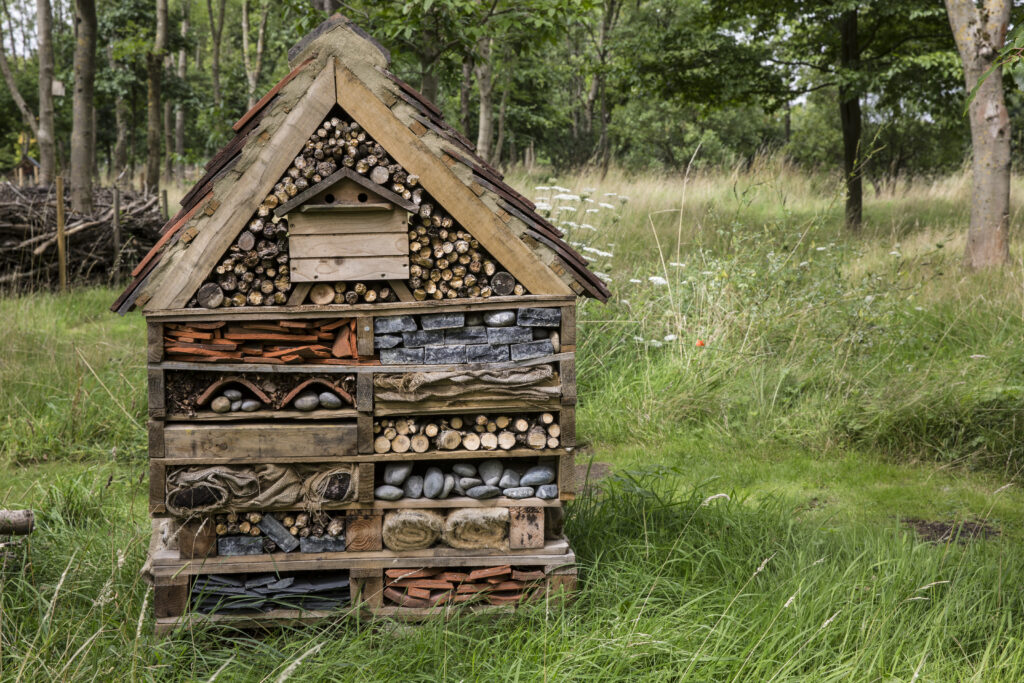
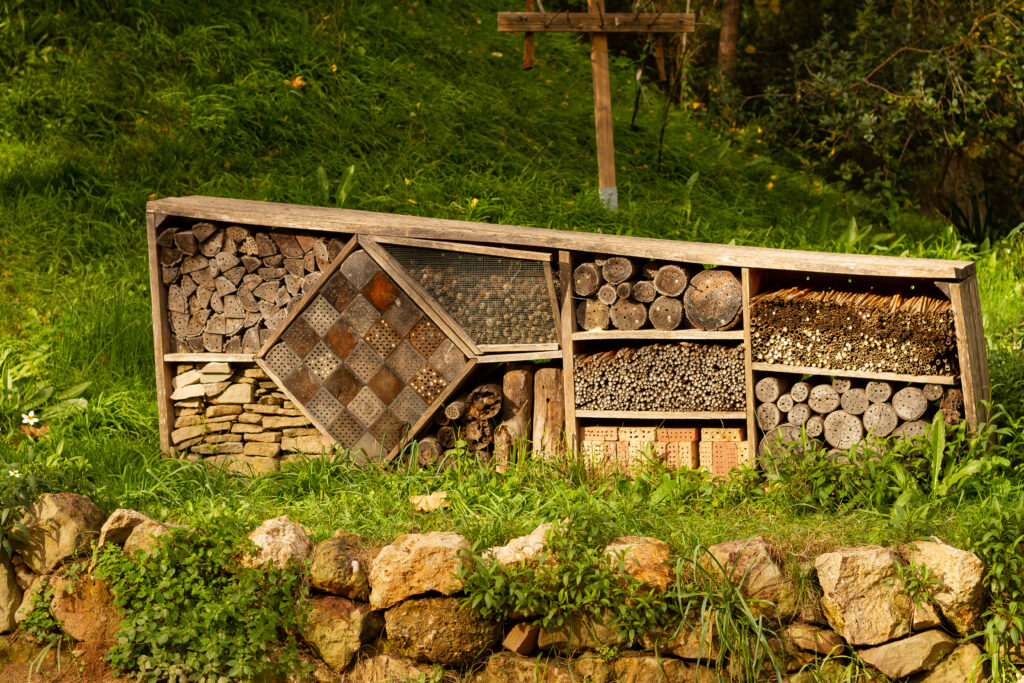
Engaging Discussion Topics for Building a Bug Hotel with Your Kids
Building a bug hotel is not only a fantastic way to get children interested in science and nature, but it’s also an excellent opportunity for meaningful discussions. Here are five engaging topics to explore as you and your young scientist embark on this DIY project together.
Material Matters
Questions to Ask: What materials should we use to build our bug hotel? Why do you think certain materials might be better than others for attracting bugs? How do we think these materials will hold up over time in the weather?
Discussion Points: Discuss the durability of natural materials like bamboo, twigs, and pine cones versus man-made materials like plastic straws or pieces of fabric. Talk about how different bugs are attracted to different textures and materials for their homes, such as wood for woodliceAn isopod is a type of small creature that belongs to the crustacean family, just like crabs and lobsters. They have a special body shape with a hard outer shell, which protects their soft insides. Learn More or dry leaves for ladybugs. This can lead to a broader conversation about recycling and the importance of using sustainable materials whenever possible.
The Seasons of Inhabitants
Questions to Ask: Which insects do we think will want to live in our bug hotel? Do we think some insects will stay all year round, or will they just visit depending on the season? Why might that be?
Discussion Points: Predict which bugs might use the hotel as a temporary shelter versus a permanent home. This could lead into an exploration of insect life cycles, migrationMigration is the regular movement of animals from one place to another, often to find food or better weather. It’s a seasonal trip that many animals take for survival. Learn More patterns, and how changes in the environment (like temperature and food availability) influence where insects decide to live.
Predator-Prey Dynamics
Questions to Ask: Can we think of any predators that might be interested in visiting our bug hotel to hunt for prey? How do insects protect themselves from predators?
Discussion Points: This discussion allows for an exploration of the food web right in your backyard. Discuss the balance of ecosystemsAn ecosystem is a community of living organisms, like insects and birds, and non-living components, like water and rocks, that interact with each other in a specific area. Learn More and the roles insects play in them, both as prey and as predators. Highlight how a bug hotel can become a micro-habitat that supports this delicate balance.
Architectural Decisions
Questions to Ask: How should we design our bug hotel to make it inviting for bugs? What features could we include to attract a diverse range of inhabitants?
Discussion Points: Encourage creativity and critical thinking by discussing the architecture of the bug hotel. Talk about the importance of compartment size, entrance holes, and the arrangement of materials. This can segue into a broader conversation about the habitats of different insects and how they build their homes in the wild.
Observational Studies
Questions to Ask: How can we keep track of which insects visit our bug hotel? What might be interesting to note about their visits?
Discussion Points: Discuss setting up a regular schedule to observe the bug hotel, perhaps making it a weekly science project. Talk about what to record, such as types of insects, number of visitors, time of day, and behavior observed. This can lead to discussions on the scientific method, the importance of observation in science, and how even backyard projects can contribute to a better understanding of the natural world.

There’s a lot to explore right where we are, in our own neighborhoods and backyards! Join us while we get off the couch and explore the everyday wonders of nature, science, space, engineering, art, and anything else we stumble upon during on our adventures.


